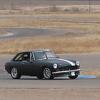Are you guys kidding me? 304 is EASY to TIG weld if you're set up for it. McKee Engineering obviously was. (Apparently their competitors were mostly still using oxy-acetylene.)
Bonus: you never have to remove rust from stainless steel before welding it.
Unlike 4130, you don't need to heat treat afterwards.
Typical UTS of mild steel: ~64,000psi
Typical UTS of Grade 304 (18/8) stainless: ~85,000psi
(You do give up a little bit in rigidity... ~193GPa vs. about ~205GPa.)
Last time we built a spaceframe out of mild steel, it took about a day to paint it and then we had to wait for the paint to dry. Then, since we were putting aluminum stressed skins on it, we had to sand half that paint off before applying adhesive. That's a lot of wasted time! (I suppose we could have masked... but that's time too.)
Then, everytime we wanted to repair or modify the frame we had to remove old paint (and sometimes some corrosion), and after the repair we had to fuss with applying new paint. Over time, paint gets all chipped up and looks unprofessional, thus more maintenance costs.
Did you read the article? Like Lotus, McKee was running coolant through frame tubes to a front-mounted radiator. The stainless tubes were obviously better suited to this old trick, whereas old Lotus frames (e.g.
Lotus 51 Formula Fords) have lots of internal corrosion issues.
Edited by BritishV8, 26 January 2010 - 22:47.




























